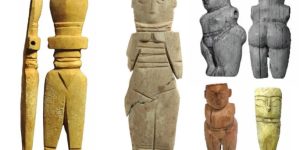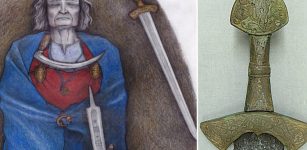Cynane: Talented Female Military Leader Assassinated While Giving A Speech
A. Sutherland - AncientPages.com - Cynane was born in 357/358 BC and died in 320 BC, only 34 years old. She came from a tradition of Illyrian female warriors who led armies in battle.
Today, our main source for Cynane is the work "Stratagems of War" written by a 2nd-century Macedonian historian, Polyaenus. Although his work is not a primary one but based on some earlier sources, there is no reason to doubt the existence of Philip II's daughter Cynane and her involvement in military encounters.
Credit: Adobe Stock - Andrey Kiselev
Cynane’s Family And Marriage
She was a Macedonian princess, the half-sister of the celebrated Alexander the Great. Her father was the Macedonian king Philip II, and her mother, Audata (ruled c. 359 – 336 BC), was an Illyrian princess and later a Macedonian queen and wife of Philip II of Macedon.
Audata, who had all the necessary military skills, trained her daughter, Cynane, in hunting, fighting, riding, and traditional Illyrian struggle.
When she was twenty years old, she was already a skilled military leader and had commanded troops during the Macedonian expansion north of the Balkans. It is believed she fought on horseback like her Illyrian ancestors, and she was accomplished in hand-to-hand combat.
Polyaenus writes, "Cynane, the daughter of Philip was famous for her military knowledge: she conducted armies, and in the field charged at the head of them. In an engagement with the Illyrians, she with her own hand slew Caeria their queen; and with great slaughter defeated the Illyrian army…"
In 339 BC, her father gave Cynane in marriage to her cousin Amyntas IV, a former king of Macedonia, by whom she had a daughter Adea (Eurydice). When Amyntas IV died, Cynane was left a widow three years later, in 336 BC. The next year, Alexander promised Cynane’s hand to Langarus, king of the Agrianians, but the latter became ill and died before Cynane’s marriage with him, could take place.
In another version, Cynane refused Alexander’s arrangements to marry off her for a second time. Cynane continued unmarried and was busy educating her daughter, Adea in martial exercises.
Cynane Was Taught The Same Military Skills As Her Half-Brother Alexander The Great
According to tradition in Illyria, noblewomen hunted, rode, and fought alongside their male counterparts.
Cynane was taught the same military skills as those possessed by her half-brother, Alexander. As a widow, she participated actively in the dynastic disputes of the Macedonians after the death of her brother Alexander in 323 BC. Alexander’s untimely death left his empire without an obvious ruler. The only possible candidate for the throne was Cynane’s half-brother Philip III Arrhidaeus.
Even though he was intellectually disabled, Philip was elected the new king in 323 BC but with no actual power. He became nothing more than the puppet king of the regent Perdiccas (c. 355 BC – 321/320 BC), a general and Alexander's former right-hand man, who participated in Alexander's campaign against Achaemenid Persia.
Perdiccas wasn’t the only Macedonian commander who wanted to be the power behind the throne. There were also other generals who decided to revolt against the regent and fight for control over Alexander's empire.
In this particular political situation, Cynane decided to make necessary arrangements for her daughter Eurydice to marry Philip.
“Unable to seize the throne for herself, she decided to arrange a sword-point wedding between her daughter and the puppet king Philip Arrhidaeus, who was Cynane’s half-brother…. Cynane mobilized her troops and headed toward the imperial capital at Babylon. Perdiccas sent an army, headed by one of Alexander’s generals, to stop her at the Macedonian border. She defeated him at the Strymon River, now the Struma, and crossed into Asia. Perdiccas sent a second army against her, led by his own brother, Alcetas, who grew up with Cynane. Perdiccas seems to have believed facing a childhood companion at the head of an opposing army would be enough to change Cynane’s mind. It didn’t…” (Toler P.D. Women Warriors)
Death Of Cynane
Polyaenus narrates that Alcetas’ forces were impressed at the sight of Cynane on the battlefield. She was a prestigious figure because she was Philip’s II daughter, Alexander’s sister, and a skilled warrior with many successes on the battlefield.
She was not afraid of Alcetas; she confronted him accusing of his lack of loyalty.
Alcetas killed her in front of his army while she was still talking to him. She did not finish her speech. The Macedonian army soldiers witnessed the murder committed by their own commander. They mutinied and forced Alcetas and Perdikkas to accept Eurydice’s marriage to Philip III.
After 317 BC, Cassander (c. 350 BC – 297 BC) a king of the Hellenic kingdom of Macedon from 305 BC until 297 BC, prepared a glorious state funeral of Cynane, Eurydice, and Philip II.
The fact still remains that Cynane, only 34 years old, died on the battlefield and it happened while she was giving her speech and not fighting an enemy soldier.
Updated on September 27, 2024
Written by – A. Sutherland - AncientPages.com Senior Staff Writer
Copyright © AncientPages.com All rights reserved. This material may not be published, broadcast, rewritten or redistributed in whole or part without the express written permission of AncientPages.com
Expand for referencesReferences:
Chugg A. The Death of Alexander the Great
Philip Freeman P. Alexander the Great
Smith W. Anthon Ch. A New Classical Dictionary Of Greek And Roman Biography, Mythology And Geography
Pomeroy S. B. Women in Hellenistic Egypt
More From Ancient Pages
-
 Small Stone Carved With A Viking Ship May Be Oldest Picture Ever Found In Iceland
Archaeology | Jun 16, 2023
Small Stone Carved With A Viking Ship May Be Oldest Picture Ever Found In Iceland
Archaeology | Jun 16, 2023 -
 The Untold Story Of Sacsayhuamán – Falcon’s Place Is Not What It Seems
Ancient Mysteries | Apr 28, 2020
The Untold Story Of Sacsayhuamán – Falcon’s Place Is Not What It Seems
Ancient Mysteries | Apr 28, 2020 -
 Mysterious Toaleans – Remains Of Unknown Humans Who Lived 8,000 Years Ago Discovered In The Leang Panninge Cave
Archaeology | Aug 26, 2021
Mysterious Toaleans – Remains Of Unknown Humans Who Lived 8,000 Years Ago Discovered In The Leang Panninge Cave
Archaeology | Aug 26, 2021 -
 How Did Hindu God Shiva Get His Third Eye?
Featured Stories | May 13, 2019
How Did Hindu God Shiva Get His Third Eye?
Featured Stories | May 13, 2019 -
 Mysterious Denny – 90,000-Year-Old Child Whose Parents Were Two Different Human Species
Featured Stories | Jul 25, 2023
Mysterious Denny – 90,000-Year-Old Child Whose Parents Were Two Different Human Species
Featured Stories | Jul 25, 2023 -
 Adorable Village Of The Little People In Connecticut
Featured Stories | Jul 25, 2019
Adorable Village Of The Little People In Connecticut
Featured Stories | Jul 25, 2019 -
 10 Surprising Facts About The Neanderthals Who Were Not As Primitive As Previously Thought
Ancient History Facts | May 6, 2017
10 Surprising Facts About The Neanderthals Who Were Not As Primitive As Previously Thought
Ancient History Facts | May 6, 2017 -
 Manticore – Legendary Persian Sphinx Whose Existence Is Still Discussed
Featured Stories | Jun 4, 2019
Manticore – Legendary Persian Sphinx Whose Existence Is Still Discussed
Featured Stories | Jun 4, 2019 -
 Strange Tuxtla Statuette And Its Undeciphered Inscription – An Epi-Olmec Puzzle
Artifacts | Mar 14, 2018
Strange Tuxtla Statuette And Its Undeciphered Inscription – An Epi-Olmec Puzzle
Artifacts | Mar 14, 2018 -
 Ancient Wooden ‘Coptic Dolls’ May Have Been The Ancestors Of Today’s Barbie Dolls
Archaeology | Sep 23, 2023
Ancient Wooden ‘Coptic Dolls’ May Have Been The Ancestors Of Today’s Barbie Dolls
Archaeology | Sep 23, 2023 -
 Ancient Greeks In Ukraine: 2000-Year-Old Settlement With Previously Unknown Structures – Localized By Polish Archaeologists
Archaeology | Nov 15, 2015
Ancient Greeks In Ukraine: 2000-Year-Old Settlement With Previously Unknown Structures – Localized By Polish Archaeologists
Archaeology | Nov 15, 2015 -
 Archaeologists Discover Mysterious Floor Made Of Bones In Alkmaar, Netherlands
Archaeology | Dec 23, 2024
Archaeologists Discover Mysterious Floor Made Of Bones In Alkmaar, Netherlands
Archaeology | Dec 23, 2024 -
 Scientists Reveal What Egyptian Faience Have To Do With Gold
Archaeology | Dec 17, 2022
Scientists Reveal What Egyptian Faience Have To Do With Gold
Archaeology | Dec 17, 2022 -
 2,000-Year-Old Lavatory In Turkey’s Denizli Province Will Be Restored
Archaeology | Aug 4, 2020
2,000-Year-Old Lavatory In Turkey’s Denizli Province Will Be Restored
Archaeology | Aug 4, 2020 -
 Mysterious Megaliths Of Russia May Offer Evidence Of An Ancient Advanced Lost Civilization
Ancient Technology | Jul 22, 2017
Mysterious Megaliths Of Russia May Offer Evidence Of An Ancient Advanced Lost Civilization
Ancient Technology | Jul 22, 2017 -
 World’s Oldest Shoe Is 5,000-Year-Old
Archaeology | Jul 10, 2015
World’s Oldest Shoe Is 5,000-Year-Old
Archaeology | Jul 10, 2015 -
 Valkyries Sigrdriva And Brynhildr: Brave Warriors Who Were Punished By God Odin In Norse And Germanic Mythology
Featured Stories | Apr 4, 2017
Valkyries Sigrdriva And Brynhildr: Brave Warriors Who Were Punished By God Odin In Norse And Germanic Mythology
Featured Stories | Apr 4, 2017 -
 Suontaka Weapon Grave: New Light On Strong Female Leaders And Warriors Of Late Iron Age Finland
Archaeology | Jul 29, 2021
Suontaka Weapon Grave: New Light On Strong Female Leaders And Warriors Of Late Iron Age Finland
Archaeology | Jul 29, 2021 -
 4,000-Year-Old Scottish Clava Cairns Were Built To House Dead
Civilizations | Nov 27, 2018
4,000-Year-Old Scottish Clava Cairns Were Built To House Dead
Civilizations | Nov 27, 2018 -
 Rare Hidden Copy Of Shakespeare Sonnet 116 Discovered In A 17th-Century Poetry Collection
Linguistic Discoveries | Mar 24, 2025
Rare Hidden Copy Of Shakespeare Sonnet 116 Discovered In A 17th-Century Poetry Collection
Linguistic Discoveries | Mar 24, 2025


